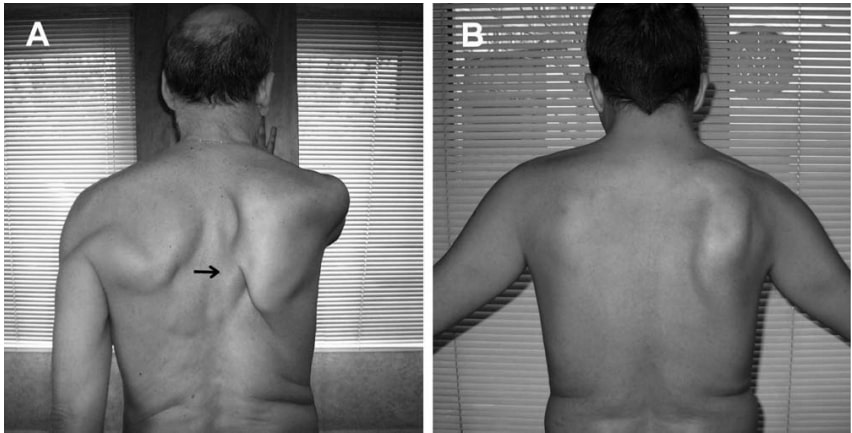Scapular Winging
From WikiMSK
It is commonly thought that scapula winging only occurs from palsy of the long thoracic nerve. This is incorrect, winging has a multitude of causes; long thoracic nerve palsy is only one cause and it is over-diagnosed. For example, spinal accessory nerve palsy (trapezius weakness) is the second most common cause of winging.
Aetiology
The causes of unilateral winged scapula in a study of 128 patients were[1]:
- Long thoracic nerve palsy (54%)
- Spinal accessory nerve palsy (30%)
- Both long thoracic and spinal accessory nerve palsy (4%)
- Facioscapulohumeral dystrophy (4%)
- Orthopaedic causes (9%)
- Voluntary (5%)
- No definitive cause (2%)
Clinical Patterns
| Long Thoracic Nerve Palsy | Spinal Accessory Nerve Palsy | |
|---|---|---|
| Classical physical signs | ||
| Muscle palsy and signs on inspection | Serratus anterior atrophy of digitations | Trapezius atrophy of lower and upper fibres |
| Side involved | Right side is 88% | Random |
| Position of scapula when winged | Medial, near the spine | Lateral, away from the spine |
| Movement that brings on or enhances winging | Forward flexion with pushing on a wall or pull ups | Abduction with external rotation against resistance |
| Additional physical signs | ||
| Ropelike lower trapezius | Raised by the medial margin of scapula and descends toward the lower thoracic vertebrae. Best seen with anterior elevation of 95-120° | Never seen because the lower trapezius is atrophied |
| Ropelike rhomboid major | Never seen because the rhomboids are masked by the normal trapezius | Rises from the inferior angle of the scapula towards the upper thoracic vertebrae, best seen at rest or near rest |
| Abrupt sliding of the scapula during lateral elevation | Never seen | Occurs with lateral elevation of at least° |
- ↑ 1.0 1.1 Seror P, Lenglet T, Nguyen C, Ouaknine M, Lefevre-Colau MM. Unilateral winged scapula: Clinical and electrodiagnostic experience with 128 cases, with special attention to long thoracic nerve palsy. Muscle Nerve. 2018 Jun;57(6):913-920. doi: 10.1002/mus.26059. Epub 2018 Feb 24. PMID: 29314072.


